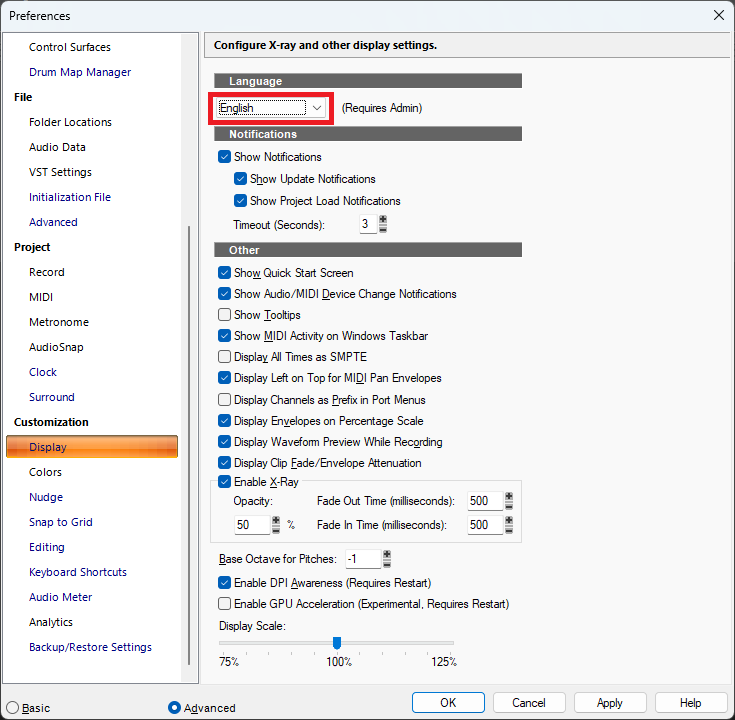-
Posts
7,209 -
Joined
-
Last visited
-
Days Won
39
Everything posted by msmcleod
-

What is the deal with Sonar and Next
msmcleod replied to DescendingIntoVertigo's topic in Cakewalk Sonar
Got it in one @Wookiee. -

Notes not displaying in Staff view**SOLVED**
msmcleod replied to Gary Lehmann's topic in Cakewalk Sonar
The font it uses is "TtsNote Standard Regular" - it should be in C:\Windows\Fonts. It's not available separately for download. -

Notes not displaying in Staff view**SOLVED**
msmcleod replied to Gary Lehmann's topic in Cakewalk Sonar
The notes in the staff view are actually a custom font, so what you describe sounds like the font hasn't installed properly. Check you've not got any restrictions on your Windows user account preventing custom font installation, and try re-installing Sonar. -
If you've got a Mackie Control Master fader assigned to the hardware out, the master fader on the Mackie will just control one side - the solution here is either: 1. Click the "lock" on the hardware output fader, so they always move together. 2. Re-assign the Mackie's Master fader to your Master bus in Sonar's Mackie Control dialog (under the utilities menu). Personally, I prefer option 2 as having the hardware output fader at unity gain is pretty much essential in order to get your audio exports at the same volume as your mix.
-
OK - ripple edit is off. There are four things I can think of that would do this: 1. You created an arranger section and moved it. 2. You made a selection and nudged it using keypad 5. 3. Somehow you invoked Project->Insert Time. 4. Assuming the clips were separate before, and they were set to absolute time, the tempo changed. [EDIT] - ahh... just re-read... you say there's a gap where there used to be audio... that would imply you made a selection and pressed delete or Del, or CTRL + X
-
Have you got ripple edit on? If you'd shown more of your screen we'd be able to tell!
-

Automation node selection problem - right-click and drag lasso
msmcleod replied to scoco's topic in Cakewalk Sonar
This has been fixed for the next update. In the meantime, opening the track lanes will allow you to lasso the nodes. -

Migration (back) to SONAR - what features from CbB are removed?
msmcleod replied to jeff s's topic in Cakewalk Sonar
I think the only ones that are missing are Workspaces and the new Backup/Restore Settings (i.e. multiple config profiles) in Preferences. -

Automation node selection problem - right-click and drag lasso
msmcleod replied to scoco's topic in Cakewalk Sonar
The only way I can get this to happen is if: 1. I accidentally move the mouse into the clip region; or 2. I select the nodes such that all of the nodes are selected within a particular time period. This is the same for me using the smart tool or the select tool. Does making the lasso region narrower (i.e. closer to the node boundaries) help? [EDIT] - ok, I can repro this if there's a clip there and take lanes are collapsed. If take lanes are expanded, then it behaves as expected. We'll investigate further. -
If input quantize is on then the MIDI is being quantized as you record it - i.e. it'll already be quantized. So quantizing afterwards is going to do nothing. Input quantize can be useful if set to a fairly coarse value (such as 1/4 notes), but if set to 1/16th notes, unless your playing is very accurate you may find notes in the "wrong" 1/16th slot. Quantizing afterwards isn't going to help as it's already quantized. It doesn't know which notes are in the wrong positions - all it knows is the ones that are there are quantized to 1/16th notes already. I'd recommend switching input quantize off, as the quantize dialog gives far more options for threshold/strength etc.
-

Cakewalk Sonar free adding underscore to wav file name
msmcleod replied to David Gardner's topic in Cakewalk Sonar
The issue is now fixed - it'll be available in the next update. -
As far as I know, nothing has changed within Quantize between CbB and Sonar - is this quantize via the Quantize Dialog, or Input Quantize?
-
Thanks - this has been fixed for the next update.
-
Press P for Preferences, then go to Customization->Display. English is always the top language in the dropdown.
-
I replied to the original post. The issue is caused by using the "Entire Mix" category when having more than one hardware output in the project. Better to use "Hardware Outputs" in this scenario.
-

Cakewalk Sonar free adding underscore to wav file name
msmcleod replied to David Gardner's topic in Cakewalk Sonar
I can now repro. The key to the repro is to have more than one audio source when doing an Entire Mix export, e.g.: 1. Load any project 2. Add an empty audio track routed to a different hardware output 3. Export using a filename of test.wav Result: file is exported as test_.wav We'll investigate this further. If you've only got one hardware output in the list, you won't get this underscore. The Entire Mix category is really special case of category "Hardware Outputs" for simple cases (i.e. one audio output). If you've got more than one hardware output, it might be better to use "Hardware Outputs" and uncheck the one you don't want to export. -

[SOLVED] VST2 Plugins causing Sonar 31.07.0.084 to crash
msmcleod replied to MikeyT's topic in Cakewalk Sonar
The latest version of Sonar (2025.07 build 97) should fix this issue. -
Ace of Wands - Steve Hackett
-
That's just how articulations work in Sonar. They apply to everything underneath them. Articulations are implemented in so many different ways within VSTi's, it would be impractical (probably impossible) to implement what you're asking for and have it work in all scenarios. In your example above, the easiest way would be to cut the duration of the articulation short of the last note.
-
There's really no reason to uninstall unless you're desperate for HDD space. Most of the installation is common to both Sonar/CbB, so you'd not be freeing up much. Also, when CbB does fail to activate, it WILL still play back if you have a problem project - only save/export is disabled.
-
The minimum specs are determined from what a sensible PC set-up would be for the average user (based on what is on the market now), assuming zero tuning of their BIOS or Windows installation. One of the most common things we hear from noobs is that they're getting clicks & pops, when they've loaded up their project with 100+ tracks containing an overkill of plugins that they saw on their favourite you-tube channels and a bunch of CPU intensive VSTi's. Having a more generous minimum spec helps to mitigate issues from these users. Of course Sonar will run on far slower hardware, and as @Starship Krupa says, my main DAW is an old i7 3770. My workflow is pretty old school though. I only started using VST's around 10 years ago - prior to that, all my instruments and effects were hardware. My 2 x DS2416 cards may have given me hardware EQ & Compression on 48 tracks, but it only gave me 4 effects processors. As such, I learned to use them sparingly, which has continued with how I use VST's nowadays.
-
@aleo- Can you send your .cwp file to @Jonathan Sasor - we'll take a look.
-
FWIW, PC-2A is included in CbB / Sonar, which is exactly the same as CA-2A except: It's a Pro-Channel only module There's no side chaining There's no Mac version





